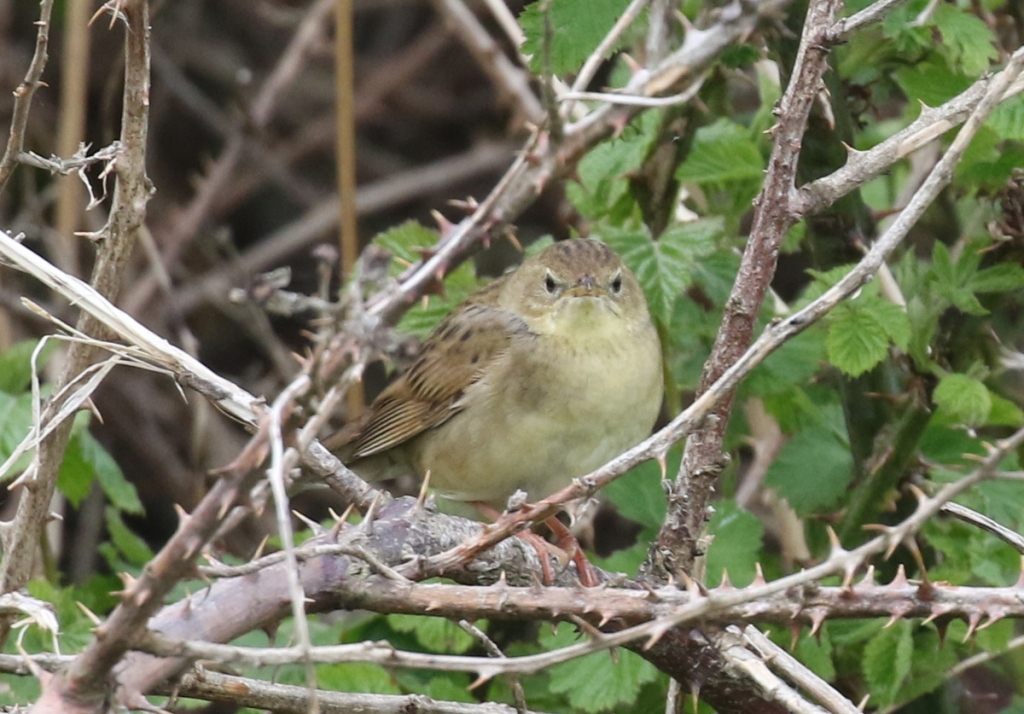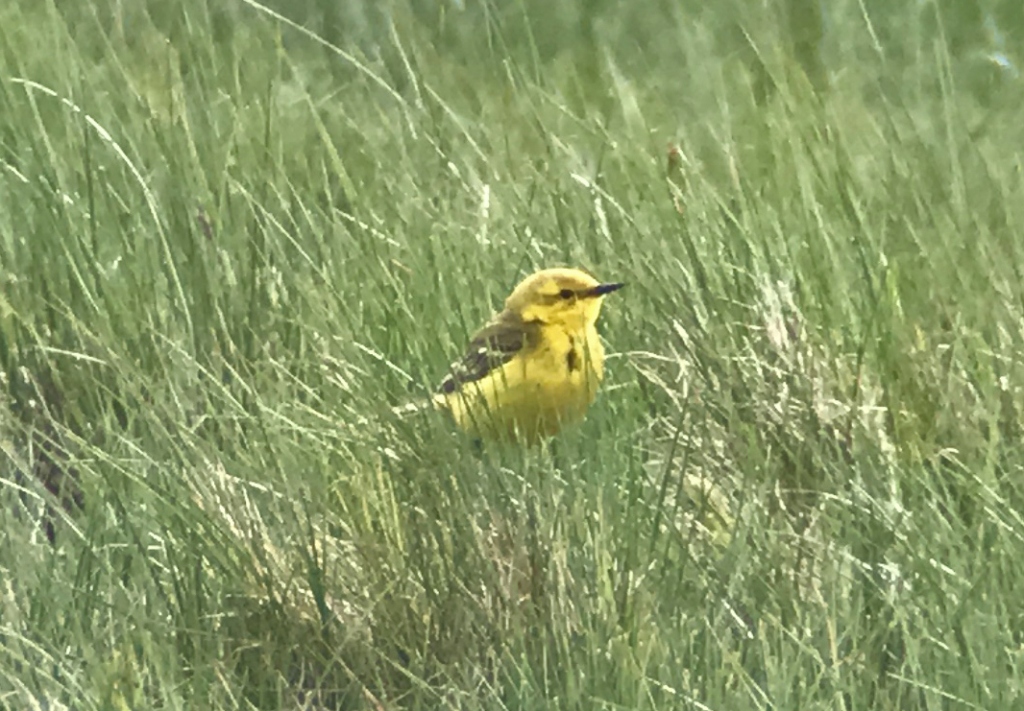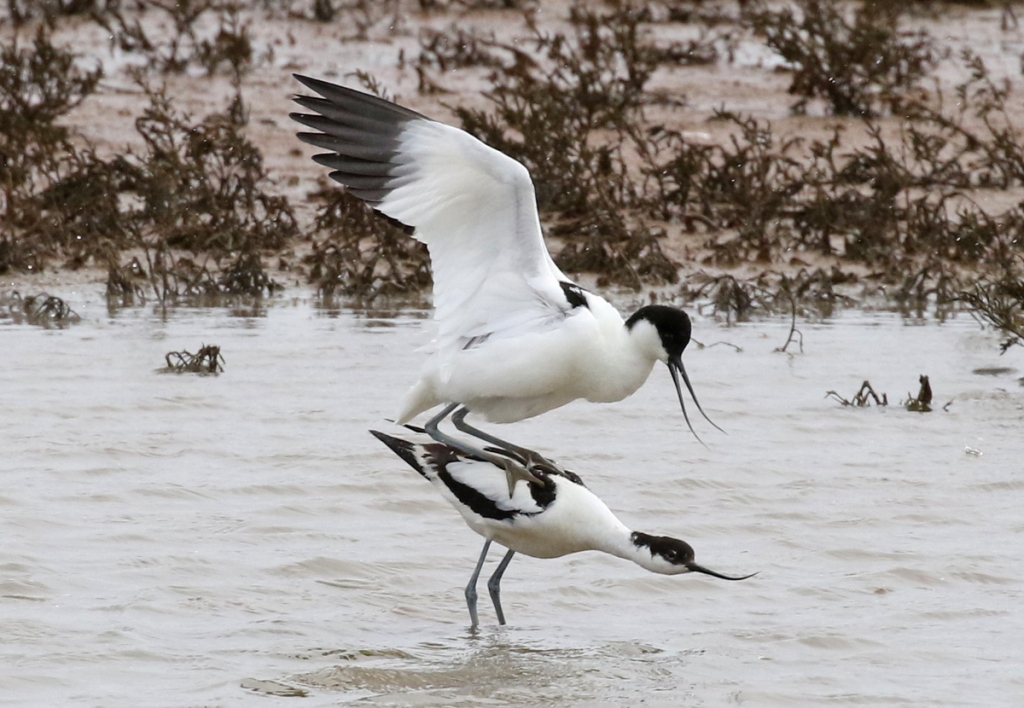Day 3 of a rescheduled 3 day Spring Tour, to take advantage of the relaxation of Covid restrictions this week, our last day. A wet & windy day today. We managed to get some birding in during the morning, but as the weather deteriorated into the afternoon, the vote was for an early finish.
We headed down to Cley for the morning and parked in the bottom car park, below the Visitor Centre. It was dry, but very grey with a rather blustery wind, but not as bad as forecast. We decided to make a bid for the East Bank while we could. There were a few birds in the trees as we set off, including our first Long-tailed Tit of the tour.
As we walked along The Skirts, a bird flew up from the short grass right next to the path, on the left. With its olive-brown back and long rounded tail, which drooped behind it as it flew, it was obviously a Grasshopper Warbler. It dropped back down into the short grass about five metres further on. We took a couple of steps forward, intending to try to find it again, and another Grasshopper Warbler flew up from the right of the path. This one flew round behind us and landed in some low brambles just a few metres away. With its rather bright lemon-yellow throat it was immediately recognisable as the male we watched reeling regularly here at the end of April and beginning of May. Hopefully it has found a mate, which would explain why it has gone quiet now.

After watching the Grasshopper Warbler for a while, it dropped down out of view. We set off again along the path as a pair of Common Pochard flew past the other way, over the reeds. There were lots of Common Swifts and hirundines hawking over the pools in the middles. A couple of Swallows and a House Martin were zooming back and forth low over the coast road, trying to find insects in the shelter of the bushes the other side.
Despite the weather, there were still warblers singing in the bushes – Blackcap, Chiffchaff, Cetti’s Warbler, and a Common Whitethroat calling its buzzy call. A Reed Warbler was singing in the reeds behind us, but the Sedge Warblers were sensibly quiet, keeping down out of the wind. A Common Buzzard was hanging in the breeze over North Foreland, until it was mobbed by one of the local Rooks.
Up on the East Bank, there were more hirundines flying round low over the grazing marshes, particularly lots of Sand Martins now. A few Swifts and House Martins flew through, up over the bank and on west, birds on the move despite the weather. Fewer than yesterday, but the movement of Swifts was a real theme of the last two days.

The grazing marshes here are perfect for breeding waders. The Lapwing chicks which were small bundles of fluff a couple of weeks ago are now getting much bigger. The Redshanks are still displaying – we saw one pair, the male fluttering his wings vigorously and calling, while the female looked disinterested and walked away. There were a few Avocets in the Serpentine and on Pope’s Pool further back.

We could hear a buzzy sound just carrying to us from out on the grazing marshes and careful scanning revealed the source – a Yellow Wagtail. This bird has been lingering here for a couple of weeks now, singing. The song is not much to write home about – just a couple of buzzy notes. We got the Yellow Wagtail in the scopes, a bright canary yellow male, and watched as it worked its way through the thick grass feeding, then climbed up onto a tussock to sing. Yellow Wagtails used to breed more commonly along the coast here, so it would be nice to think that they might return.

We stopped again to scan the margins of the Serpentine and Pope’s Pool. There were lots of Greylags and a few Canada Geese, several Gadwall, Mallard and Shelduck but we couldn’t pick out anything different. The Great Black-backed Gulls were starting to gather to loaf on the islands at the back.
A Yellow Wagtail called, and we turned to see the male fly round over the bank, before landing briefly on the grass behind the reeds below us. It didn’t stay though, flying straight back out to the middle where it had been singing. As it flew back, a second Yellow Wagtail flew up too, but didn’t follow the male, landing on the edge of the Serpentine. We could see it was a female – just a shame she wasn’t showing any interest in the singing male!
Carrying on to Arnold’s Marsh, we got into the shelter, out of the wind, just as it started to rain. A couple of people already in the shelter asked what the wader at the back was. So we set up our scopes to find it was a lone grey Knot (with a limp). There were also two Dunlin, a Ringed Plover and a Turnstone with it. A couple of Curlew were roosting in the far corner and another was sheltering behind a low suaeda bush the other side. There were a few more Redshanks on here too.
Two other Ringed Plovers emerged from the low saltmarsh vegetation at the back – the slightly larger paler one, chasing after the slightly smaller darker bird. Two different subspecies of Ringed Plover, the smaller, darker birds are northern, tundra breeders (race tundrae), compared to the larger paler local breeders (race hiaticula). The Tundra Ringed Plovers are later migrants, passing through at this time of year. Another nine Tundra Ringed Plovers then dropped in just to illustrate the point, along with three more Dunlin.
One of the group spotted a distant Hobby, over the reedbed at the back, flying towards Salthouse, heading inland presumably out of the deteriorating weather. A Little Tern hovering over Sea Pool was similarly distant, but a Sandwich Tern dropped in at the back of Arnold’s, with more flying through past the shelter. A single Wheatear on the sand right at the back was flitting in and out of the low vegetation, trying to feed. There is still a trickle of late Wheatears coming through, dark northern breeders, but this was the first we had seen this tour.
There were several Avocets coming and going from the pool down at the front, with a couple sat down on the bank beyond, presumably incubating. When a female stopped and stood with neck bent down and bill held horizontal just above the surface, the male walked round her preening and flicking his bill in the water. We knew what was coming and sure enough we then watched the pair mating.

As the rain eased, we continued on to the beach. We counted nine Little Terns offshore, slowly working their way east, and several Sandwich Terns passed the other way, one with a large sand eel in its bill. We steeled ourselves and turned into the wind for the walk back. We had intended to call in at Bishop Hide on the way back, as this is open again now, but we found several people camped in there already, out of the weather. We scanned from the door and couldn’t see anything of note on Pat’s Pool anyway, so we walked back. A pair of Mute Swans with cygnets were on the channel up from the bridge.
We figured it might be a bit more sheltered at Kelling, so we headed over there next. As we walked into the lane, we could hear a Greenfinch wheezing. Several Goldfinches were feeding on the school playing field and a Chaffinch was singing from somewhere in the school grounds as we passed. The hedges either side were rather quiet, despite being out of the wind. We did hear a Common Whitethroat calling, a Blackcap singing and a Chiffchaff flew across. A Red-legged Partridge ran ahead of us all the way down the lane to the copse.
We stopped to scan from the gate. There were lots of Brown Hares in the field beyond the Water Meadow, in the shelter of the hedge, and loads of Woodpigeons and Rooks. All we could find was a single Robin on the sheltered edge of the copse.
We continued down to the cross track to look at the pool, but there was just a single Egyptian Goose and a few Mallard on there today. It was rather exposed out here in the increasingly blustery wind. We scanned the bushes around the Quags, but everything seemed to have gone somewhere more sheltered. As we turned to walk back, there were a couple of Linnets in the edge of the field and a slightly bedraggled Common Whitethroat feeding in the low alexanders by the path which flew up into the brambles as we passed.

Kelling Heath seemed like a place which might offer a bit of shelter, and there have been Garden Warblers singing here in the last week, but it was windier than we thought in the car park. At least it wasn’t raining, so we had a quick walk round the bushes. A Blackcap was singing from deep in the blackthorn by the car park and a Bullfinch called as we walked round the back.
Then we heard a Garden Warbler across the road, so we crossed over to see if we could find it. It was singing in some dense blackthorn, moving around, and we couldn’t see it before it went quiet. We did find a family of Long-tailed Tits in the bushes, and a Willow Warbler and Goldcrest flitting around in the birches.
It was time for lunch, so we headed back down to Cley to try to find some shelter. We parked the minibus in front of the beach shelter and ate our lunch in there. It was a bit damp on the bench, but standing in one side it was drier and had the added advantage of being able to see the sea. A steady stream of Sandwich Terns flew past, along with one or two Little Terns and a single Common Tern.
After lunch, we drove round to Iron Road for a short walk to see if any waders had dropped in there. There was nothing new on the large pool, but a Marsh Harrier was hanging in the air over the reeds at the back. On the other side of the main drain, over the bridge, we did find a small group of Tundra Ringed Plovers and several Dunlin on the muddy brackish pools. A Yellow Wagtail flew round calling but landed in the long grass with the cows further back, out of view.
The plan had been to finish up at Wells, so we decided to head over there now, with a view to finishing slightly early. The forecast was for heavy rain all this afternoon, and it finally arrived on our way there. The wind had picked up too – it had been forecast to be gusting 50mph+ all day, so we had actually been lucky to have had nothing like that up til now.
We got out of the minibus and started to scan the pools from the parking area. We could see a Little Ringed Plover on the pool west of the track. We thought about a walk down to the far end of the pools to see if there was anything hiding in the rushes, but there was no appetite for even a short walk now. It was already 3pm, and we had made the most of it, so with everyone having a long drive home we decided to call it a day.
It was a good call, as it only got wetter on the way back. But despite the deteriorating weather at the end, we could look back on a very productive three days of spring birding and we had seen some very good birds too.
















